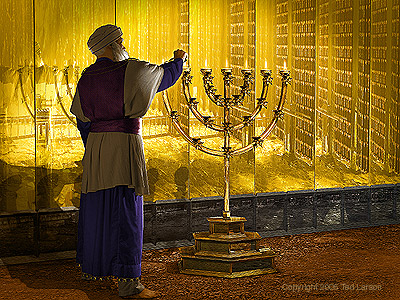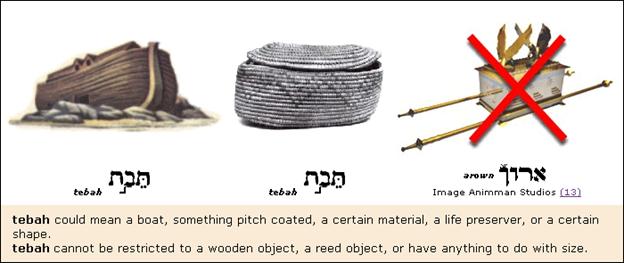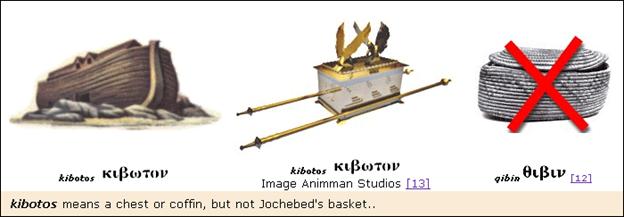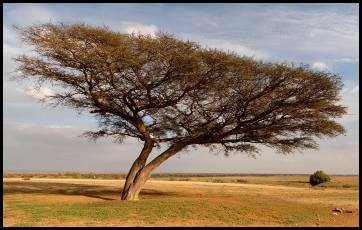Blueprints: Items inside Tabernacle 25:10-40
The remainder of chapter 25 discusses construction for three of the four furniture items that will ultimately go inside the tent of meeting in holy place or most holy place.
| Item | Location |
|
|
Most Holy Place |
|
|
Holy Place |
|
|
Holy Place |
|
|
Holy Place |
 |
Construction of the altar of incense is described much later in Exodus 30:1-10. As you read this segment, ask yourself why the Altar of Incense is not described with the other items in the holy places but where it is instead? |
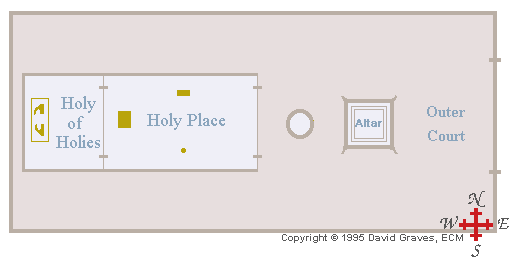
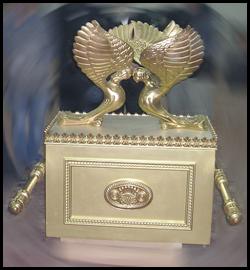 Ark of Covenant and its Mercy Seat 25:10-22
Ark of Covenant and its Mercy Seat 25:10-22
Ark of Covenant (Testimony) 25:10-16
Ark (n.) – a chest or box.
The Ark of the Covenant is the only item kept in the Holy of Holies, so perhaps it is fitting it is described first. It is made of acacia wood overlaid with pure gold, and has gold molding (trim) and permanently attached poles for carrying.
Instructions are also given at this point that a “testimony” would be given later to be stored inside the ark. Later on we will discover that the testimony consists of the stones the Lord wrote the commandments on, Aaron’s rod that budded, and a pot of manna. Essentially, the contents are a record of God’s law and covenants.
“The two tables of stone which constituted the “testimony” or evidence of God’s covenant with the people (Deut. 31:26), the “pot of manna” (Ex. 16:33), and “Aaron’s rod that budded” (Num. 17:10), were laid up in the ark (Heb. 9:4).” -Eastons Bible Dictionary
| Ark vs. Ark (One of these arks is not like the others…) |
|
Noah’s Ark, Moses’s Ark, and Ark of the Covenant. Three different “arks” in the bible. In Hebrew, the ark used for Noah’s Ark and Moses’s Ark are the same, tebah, but the ark used for ark of the Covenant is arown. Tebah is only used in the bible in the context of these two arks, so its exact meaning is uncertain. It isn’t the same word ship or basket used in other places in the bible. It might mean anything from boat to lifesaver. Arwon (Strongs #727) is also used in Kings and Chronicles six times translated as chest, and once in Genesis as coffin (for Joseph).
When you throw in the Septuagint (Greek Old Testament) things get even more interesting, as suddenly now, the word for the Noah’s Ark and the Ark of the Covenant are the same, kibotos, but now the Ark carrying baby Moses has changed into qibin (wicker basket).
What conclusions can you draw from this? |
What is significant about the Ark being made of acacia wood covered in Gold?
| Acacia Wood |
|
Acacia Wood comes from Acacia trees which grow well in desert climates like parts of Africa, Australia, and the Middle East. There are thousands of variants of acacia tress. Some believe the acacia wood (“shittim” or “shittah” wood) in the bible comes from, perhaps, the Acacia seyal (the gum-arabic tree), the Acacia torilis or Acacia nilotica These trees grow in the Sinai area. The wood is light, hard, and durable, and grows very black with age. The timer is close-grained and is not readily attacked by insects. Perhaps this is why Septuagint designates acacia as “incorruptible wood”. |
Acacia wood
- What are the properties of Acacia wood?
- properties: hard, incorruptible, indestructible, native to Sinai desert
- Wood is not as durable or eternal or heavy as gold.
- Josephus describes the wood used in the tabernacle as “the best sorts of wood” that “would not at all decay by putrefaction” and “naturally strong” and such that “could not be corrupted”.
- Wood comes from a living object (trees)
Covered in gold
- What does Gold signify in the bible? In revelation, the streets are paved with pure gold (Rev. 21:21).
- Pro 17:3 The refining pot is for silver and the furnace for gold, But the LORD tests hearts.
- Mal 3:3 “He will sit as a smelter and purifier of silver, and He will purify the sons of Levi and refine them like gold and silver, so that they may present to the LORD offerings in righteousness.
- -crowns are made of Gold (several bible refs)
- – Gold signifies Christ’s divine nature
- 1Co 3:16 Do you not know that you are a temple of God and that the Spirit of God dwells in you?
- Unger interprets wood as denoting the humanity of Christ and the pure gold as denoting Christ’s perfect humanity. Others see the gold more as Christ’s divine nature.
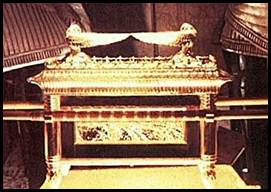
Ark of the Covenant as depicted in
the movie Raiders of the Lost Ark
“…I noticed something different about the ‘Ark of the Covenant’ when comparing it to the other items of furniture in the Tabernacle. The gold rings through which the poles were passed in order to carry each item of furniture from one location to another were fixed at the ‘top’ corners of every item except the Ark. The rings on the Ark of the Covenant were fixed on the four ‘bottom’ corners! I thought about this for a while, then I realised that when the Levites went to pick up the Ark, they had to ‘bow down!’ Also, this made the Ark the only item of furniture that was carried above shoulder height… Most pictures (on the internet) of the ‘Ark of the Covenant’ show the poles in the wrong position. This is a common mistake, made also by the makers of the Harrison Ford film ‘Raiders of the Lost Ark’.” -Graham D. Kennedy
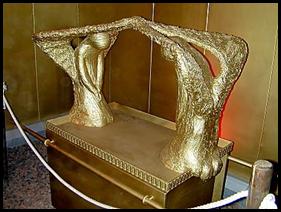 Mercy Seat 25:17-22
Mercy Seat 25:17-22
- The mercy seat sits on top of the ark of the covenant inside the holy of holies.
- According to Josephus, the mercy seat was attached to the ark with golden hinges.
- The ark was not to be drawn in carts by beastes of burden, but rather borne on the shoulders of priests.
“Upon this its cover were two images, which the Hebrews call Cherubims; they are flying creatures, but their form is not like to that of any of the creatures which men have seen, though Moses said he had seen such beings near the throne of God.”–Josephus
“The mercy seat and cherubim consisted of one integral unit made from solid beaten gold. Perhaps this speaks of His glory and deity being one. The only other article within the tabernacle similarly constructed was the candlestick”–Josephus
| Item | Unger’s Symbolic Interpretation |
| Acacia wood | Humanity of Christ |
| Gold | Christ’s perfect humanity |
| Pot of Manna | Christ as Life-sustainer |
| Ten Commandments (in ark) | Christ as having God’s law in his heart |
| Aaron’s Rod that budded | Christ in the resurrection |
| Mercy seat | Divine throne is transformed from a throne of judgment to a throne of grace by atoning blood sprinkled upon it |
| Cherubim | guardianship of the holiness of God’s throne |
Unger – shekinah glory presence of the lord above the cherubim.
Unger – tabernacle symbolism = God working outward in his outreach to man
Cherubim were “winged lions with human heads known from contemporary iconography” according to Unger.
| Item | Unger’s Symbolic Interpretation |
| Showbread | Christ the bread of life, nourisher of the believer as a priest |
| Golden Candlestick | a type of Christ our light, shining in the plentitude of the spirit. |
| Linen curtains | speaks of various aspects of the personal work of Christ (see colors) |
| white | purity |
| blue | color of heaven |
| purple | color of royalty |
| scarlet | color of blood |
| curtain separating holy place from most holy place | flesh (sinless humanity) of our Lord (Heb 10:20). (When Christ died, the curtain of the temple torn in two opening a new and living way directly into God’s presence) |
| bronze altar | death of christ on the cross, our whole burnt offering who offered himselfe without spot to God |
| shedding of blood | atonement |
| brass | divine judgment (Num 21:9. Jn 3:14) |
| court gate | christ, our access to God (by virtue of his redemptive work |
|
|
Moses face shone physically when he spent time in the physical presence of God. What happens when we spend spiritual time in the presence of God? |
Let’s talk sizes for a minute…
|
Item
|
Size
|
A 20.5″ Royal Cubit would mean…
|
| Ark of the Covenant | 2.5 x 1.5 x 1.5 cubits | approx. 4’3″ wide by 2’6″ tall by 2’6″ deep |
| Mercy Seat | 2.5 x 1.5 cubits | |
| Cherubim | Not Specified |
See sidebar on cubits. Using conversion factor 20.5″ to the cubit, the ark is approximately 4’3″ wide by 2’6″ tall by 2’6″ deep, plus whatever additional height the sculpted cherubim add.
SEE SIDEBAR ON CHERUBIM (separate file)
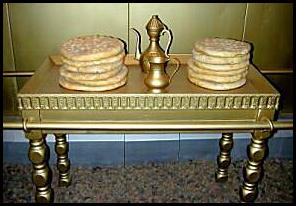 Table of Showbread 25:23-30
Table of Showbread 25:23-30
The showbread is also called showbread or “bread of presence” (as the bread is always in the Lord’s presence). The holy bread is only allowed to be eaten in the holy place and only by priests. The table and bread are a picture of God’s willingness to fellowship and commune with man.
Mt 26:26, Jn 6:35, 45-50, Rev 3:20
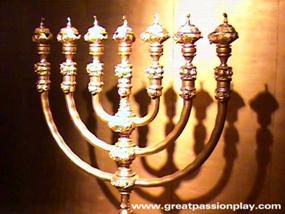 Golden Lampstand 25:31-40
Golden Lampstand 25:31-40
The Lampstand is a menorah or candlestick. The size is not specified in the building instructions, but since it is to be hammered out of a single piece of pure gold, that may be a limiting factor in size.
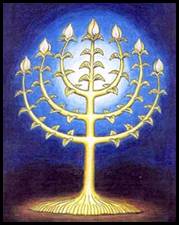
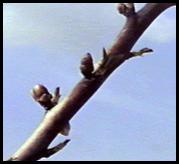
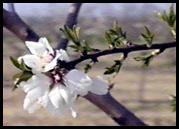
The branches are supposed to look like almond trees, with buds, blossoms and flowers. There are seven branches (7 is number of completeness)
The priests are to keep the Lampstand burning continuously. (See Lev 24:1-4)
Lev 24:1-4, Then the LORD spoke to Moses, saying, “Command the sons of Israel that they bring to you clear oil from beaten olivesfor the light, to make a lamp burn continually. Outside the veil of testimony in the tent of meeting [AKA the tabernacle], Aaron shall keep it in order from evening to morning before the LORD continually; it shall be a perpetual statute throughout your generations. He shall keep the lamps in order on the pure gold lampstand before the LORD continually.”
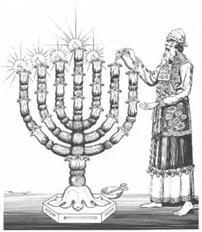 The Lampstand is the only source of light in the Holy Place.
The Lampstand is the only source of light in the Holy Place.
Significance?
- Jesus gives light to every man (Jn 1:19)
- We are children of light (Eph 5:8)
- Our light source is Jesus.
- Mt 5:14, 16, John 15:5 (vine, branches)
The light from the Lampstand allows the priests to fellowship with God and intercede for God’s people (by doing…)
